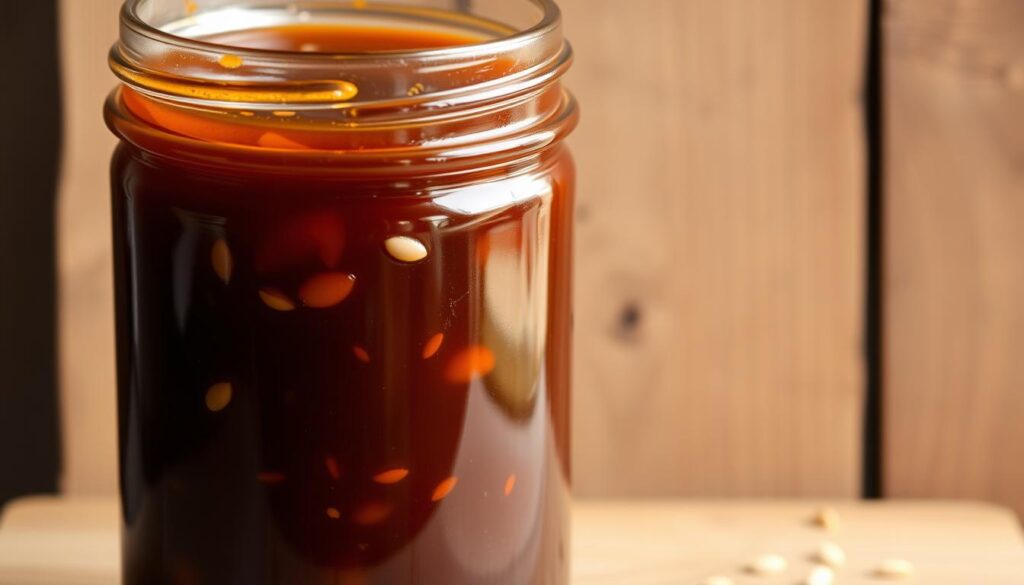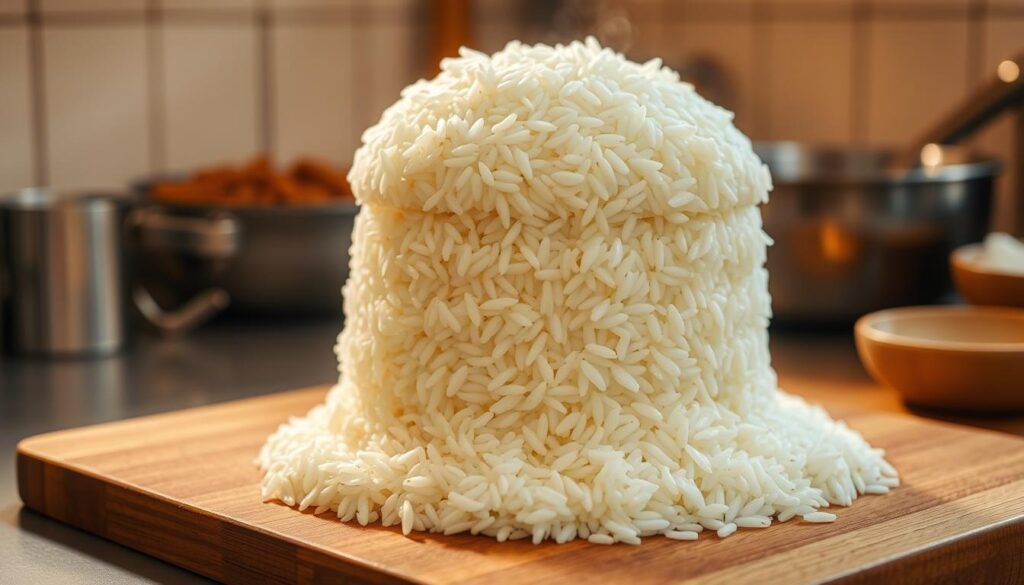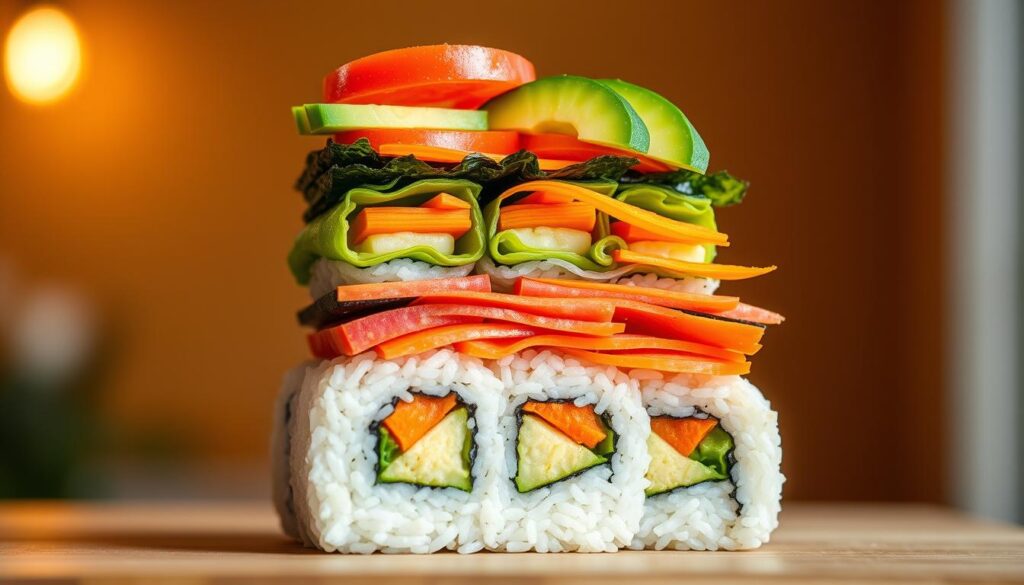Imagine hosting friends for dinner and wanting something both impressive and nourishing. Last summer, my neighbor Jenna faced this exact challenge. She craved a meal that felt special but didn’t require hours in the kitchen. Her solution? A vibrant Asian fusion recipe layered with flaky fish, creamy avocado, and sticky rice – all assembled in minutes.
This dish isn’t just about looks. Wild-caught salmon delivers Omega-3 fatty acids, while avocado adds monounsaturated fats to support heart health. Sushi rice provides slow-release carbs, making it ideal for sustained energy. Whether you’re meal-prepping or entertaining, the blend of Japanese-inspired flavors and California freshness works beautifully.
What makes this stacked sushi recipe stand out? It’s gluten-free, customizable, and ready in under 30 minutes. Swap ingredients based on dietary needs or seasonal produce. Serve it as individual towers for a dinner party or deconstruct it for quick lunches. The balance of savory teriyaki glaze against buttery avocado creates a perfect harmony you’ll want to repeat weekly.
Key Takeaways
- Combines Japanese and Californian flavors in one nutrient-packed meal
- Rich in Omega-3s from salmon and heart-healthy fats from avocado
- Uses sushi rice for better texture and digestion-friendly starch
- Quick to assemble for casual meals or elegant presentations
- Easily adaptable for gluten-free or low-carb diets
Why This Dish Wins Dinner
This teriyaki salmon avocado rice stack is more than just a recipe. It’s a game-changer for dinner. It combines bold flavors with smart nutrition, solving the “what’s for dinner?” question. Plus, it brings restaurant-quality appeal right to your kitchen.
Nutritional Powerhouse Combination
At just 450 calories per serving, this stack is a nutritional powerhouse. It has 30g of protein from fresh salmon. The avocado adds monounsaturated fats for heart health, and the rice provides lasting energy.
Together, these ingredients offer:
- A complete protein source with all essential amino acids
- Healthy fats that boost nutrient absorption
- Complex carbs for sustained fuel
Visual Appeal Factors
The magic happens in the layers. Pink salmon, creamy avocado slices, and white rice create a stunning color trio. Top chefs suggest:
- Using ring molds for perfect cylindrical shapes
- Drizzling sauce in zigzag patterns
- Adding black sesame seeds for contrast
This Japanese-inspired meal is not just tasty—it’s a feast for the eyes. The vertical presentation turns dinner into an edible work of art. It proves healthy food can be stunning.
Essential Ingredients Breakdown
Creating a great teriyaki salmon avocado rice stack begins with picking the right ingredients. Each part adds to the dish’s taste, texture, and health benefits. It’s important to know why swapping out ingredients can change the dish.
Protein Components
Wild-caught salmon has a richer taste and more omega-3s than farmed salmon. Choose salmon with bright flesh and a firm texture. For a cheaper option, try frozen sockeye salmon thawed slowly in the fridge.
| Salmon Type | Best For | Prep Tip |
|---|---|---|
| Wild King | Premium texture | Marinate 30 mins |
| Farmed Atlantic | Cost efficiency | Pat dry before cooking |
Rice Variety Options
Sushi rice makes the stack hold together well. Brown rice adds a nutty flavor. If you prefer quinoa, use it 1:1 and add a bit of rice vinegar to get that sushi taste.
- Short-grain rice: Classic sticky base
- Jasmine rice: Floral aroma boost
- Cauliflower rice: Low-carb alternative
Avocado Selection Guide
Hass avocados are the best for their creamy texture and easy skin. Check if they’re ripe by pressing near the stem. They should be slightly soft but not mushy. To ripen avocados faster, store them in a paper bag with bananas.
“The perfect avocado feels like a ripe peach – firm yet forgiving under gentle pressure.”
Must-Have Kitchen Tools
Your kitchen gadgets are key to making this Asian-inspired dish a hit. They help mix flavors and make your gourmet rice stack look great on Instagram.
Specialized Equipment
A flexible fish spatula is essential for flipping salmon without breaking it. Choose one with a thin edge for easy sliding under fish. Rice cookers with fuzzy logic technology make sure your rice is always fluffy.
Ring molds turn simple ingredients into fancy stacks. For a cheap alternative, use tuna cans with both ends cut off. An instant-read thermometer is also crucial for cooking salmon to the perfect 125°F.
Presentation Essentials
Japanese garnishing tools take your dish to the next level. Here are some must-haves:
- Nori punches for making cool seaweed shapes
- Sesame seed shakers with different patterns
- Microplane for light, fluffy citrus zest
Square bamboo plates add to the Asian-inspired look. Tweezers are great for placing microgreens or edible flowers just right.
Homemade Teriyaki Sauce Mastery

Your delicious salmon stack recipe gets even better with homemade teriyaki sauce. Making it yourself lets you adjust sweetness, saltiness, and thickness just right. We’ll look at two ways to make it, one for those who love detail and another for those short on time. Plus, we’ll share tips for making it even more flavorful.
Traditional vs Quick Versions
The traditional way involves simmering sake, mirin, and soy sauce for over 30 minutes. This method, inspired by old preservation techniques, brings out deep, rich flavors. For a quicker option, try this 15-minute shortcut:
| Method | Key Ingredients | Time |
|---|---|---|
| Traditional | Fermented soy sauce, authentic mirin | 45 mins |
| Quick | Cornstarch slurry, garlic powder | 12 mins |
Flavor Balancing Techniques
Learn these tweaks to enhance your homemade teriyaki sauce:
- Too sweet? Add rice vinegar ½ tsp at a time
- Lacking depth? Simmer with kombu seaweed
- Overly salty? Stir in pineapple juice
For special diets, use maple syrup instead of honey or coconut aminos. Always taste as you go. The perfect glaze should highlight your salmon without overpowering it.
Salmon Preparation Perfection
Learning how to prepare salmon can make this Japanese fusion dish truly special. We’ll share expert tips for handling fish like a pro, without needing years of training.
Filleting Techniques
Pin-bone removal is key for any fish expert. Feel the fillet’s surface to find tiny bones. Use tweezers to pull them out in the right direction, so you don’t tear the fish.
For perfect caramelization, score the fish:
- Hold your knife at a 45-degree angle
- Make shallow cuts 1 inch apart
- Then, make cuts in the opposite direction
This diamond pattern helps the marinade soak deeper and makes the edges crispy when seared.
Marinating Methods
The 15-minute marinade is a game-changer, thanks to science. Sake’s acidity breaks down proteins without making the fish mushy. For the best results:
- Use equal parts soy sauce and mirin
- Add 1 tbsp grated ginger per fillet
- Include 1 tsp sesame oil for extra richness
Pat the skin dry before cooking for that glass-like crispness everyone loves. A pro tip: Place the skin-side down in a cold pan, then slowly heat it up for perfect texture every time.
Rice Cooking Fundamentals

Learning to cook rice is key to making a stunning Asian rice stack. It’s not just about following a recipe. It’s about getting the texture and flavor right. This is the base of your layered dish.
The Water Equation Demystified
Each type of rice needs a certain amount of water. Sushi rice needs exactly as much water as rice. Brown rice, on the other hand, needs 1.5 cups of water for every cup of rice. Here’s a table to help you figure it out:
| Rice Type | Water Ratio | Cook Time | Best Texture For |
|---|---|---|---|
| Sushi Rice | 1:1 | 18 mins | Sticky layers |
| Brown Rice | 1.5:1 | 35 mins | Chewy base |
| Jasmine Rice | 1.25:1 | 12 mins | Fluffy texture |
Flavor Enhancement Tricks
Make your rice taste amazing with these chef-approved tips:
- Mix rice vinegar with a pinch of sugar while grains cool
- Swap salt for furikake seasoning (try sesame or seaweed blends)
- Steam with kombu seaweed for umami depth
Spread cooked rice on a baking sheet to cool completely before stacking. This stops moisture from ruining your healthy seafood meal. If the rice feels damp, gently pat it with paper towels.
Avocado Handling Secrets
Perfectly prepped avocado makes every layer of your rice stack special. It turns a simple meal into a delicious avocado recipe. Professionals share their secrets to use every bit of this creamy fruit.
Cutting Techniques
Begin by slicing vertically around the pit and twisting the halves apart. Use a radial cutting method for even wedges. Make lengthwise cuts through the flesh but not the skin, then scoop with a spoon. This method makes slices that look great and stay in shape.
Pro tip: Rub exposed avocado flesh with lime juice right after cutting. This stops browning and adds a tangy flavor. It pairs well with the teriyaki glaze in your easy dinner idea.
Seasoning Approaches
Go beyond just salt with these flavor enhancers:
- Yuzu kosho: A citrus-chili paste that adds bright heat
- Tajín: Lime-infused chili powder for zesty crunch
- Toasted sesame oil: Enhances richness without overpowering
Season avocados just before you put your stack together. This keeps the texture firm and flavors bright. It’s essential for a restaurant-quality look at home.
Stack Assembly Blueprint
Creating a perfect homemade rice stack is all about precision and creativity. It’s like building edible architecture. Each layer is crucial for both taste and looks. Here are simple steps to make your dish look like it came from a restaurant.
Layering Sequence
Begin with a clean ring mold coated with oil. For the best taste, follow this order:
- Base layer: Press ½ cup cooked rice firmly but not too hard. It should hold its shape well.
- Protein placement: Place teriyaki salmon chunks in a circle, leaving the center empty.
- Avocado crown: Arrange sliced avocado over the salmon, making sure the edges touch the mold.
Tip: Chill the ingredients for 15 minutes in summer to keep the stack from falling apart. This keeps everything fresh and in place.
Structural Integrity Tips
Three tips will help your salmon avocado dish stay perfect:
- Press the rice with damp hands to avoid sticking.
- Leave a ¼-inch gap between layers and the mold.
- Remove the mold slowly, supporting the base with your other hand.
For a fancy touch, add nori strips between the rice and salmon. They look great and help hold everything together.
Professional Presentation Tips
To make your teriyaki salmon avocado rice stack look restaurant-worthy, focus on two things: how you plate it and what garnishes you use. These details turn your dish into a visually stunning masterpiece that honors its Asian roots.
Plating Techniques That Impress
Begin with a wide, shallow bowl to highlight the stack’s layers. Drizzle teriyaki sauce in a circular motion to create beautiful swirls at the base. For a modern touch, try these expert tips:
- Offset stacking: Tilt each layer slightly for dynamic visual interest
- Negative space: Leave 40% of the plate sauce-free for clean presentation
- Height variation: Add avocado slices at different angles
Garnish Selection Secrets
The perfect toppings add texture and highlight the dish’s Asian flair. Here’s a comparison table for popular garnishes:
| Garnish Type | Visual Impact | Flavor Boost |
|---|---|---|
| Black sesame seeds | High contrast on light ingredients | Nutty, earthy notes |
| White sesame seeds | Subtle texture enhancement | Mild crunch |
| Furikake blend | Colorful specks throughout | Umami explosion |
| Microgreens | Vertical height element | Fresh, peppery finish |
For special events, add edible flowers around the plate’s rim. Make sure to place garnishes just before serving to keep them fresh and colorful.
Creative Recipe Variations

This dish is a blank canvas for your creativity. You can adjust flavors to fit any taste or dietary need. It’s perfect for hosting guests with different tastes or for trying new things. These smart changes keep the meal exciting and healthy.
Mix Up Your Protein Choices
Salmon’s rich flavor pairs perfectly with alternatives that bring new textures to your stack. Try these popular swaps:
- Tuna steaks (seared rare) for a bold, meaty twist
- Marinated shrimp skewers with citrus notes
- Crispy tofu cubes seasoned with sesame – ideal for vegetarian sushi stack enthusiasts
For pescatarian options, smoked trout adds depth, while chicken works beautifully with teriyaki glaze adjustments. Always match your protein’s cooking time to maintain perfect doneness.
Adapt for Special Diets
Transform this healthy seafood recipe into allergy-friendly or low-carb meals without sacrificing satisfaction:
- Use tamari instead of soy sauce for gluten-free needs
- Swap white rice with cauliflower rice (riced fresh or frozen)
- Add spiralized zucchini layers for extra veggies
Nutrition coach Maya Carter suggests:
“Layer in pickled ginger or wasabi-infused avocado for gut-friendly probiotics that enhance flavor complexity.”
Vegan versions shine with marinated portobello mushrooms and coconut aminos. For keto diets, increase avocado portions and add crushed macadamia nuts between layers.
Meal Prep & Storage Solutions
Learn how to keep your teriyaki salmon stacks fresh and tasty for days. The right storage keeps the dish’s vibrant textures. It also makes it a quick healthy dinner idea for when you’re busy. Discover how to enjoy your cooking for longer without losing quality.
Refrigeration Guidelines
Store each part separately to keep its texture. Here’s what to do:
- Cool rice completely before sealing in airtight containers
- Wrap avocado slices in beeswax paper to prevent browning
- Keep salmon in shallow dishes with sauce for maximum flavor
Assembled stacks stay fresh for up to 2 days. But the sauce stays zesty for 5 days when stored separately. For easy meal prep, layer ingredients in mason jars. Start with rice at the bottom, proteins in the middle, and greens on top.
Freezing Considerations
Freezing can save you time:
- Vacuum-seal marinated salmon portions for up to 3 months
- Freeze rice in single-serving molds for quick reheating
- Store sauce in ice cube trays for portion control
Thaw components overnight in the fridge before assembling. Don’t freeze avocados – their texture changes. This way, your healthy dinner idea is always ready to go, tasting like it was just made.
Health Benefit Breakdown
This vibrant dish isn’t just Instagram-worthy – it’s packed with science-backed benefits. It’s a smart choice for health-conscious food lovers. Let’s explore how each component works together to support your well-being.
Your Heart’s New Best Friend
Wild-caught salmon delivers a powerful dose of Omega-3 fatty acids. A 6-oz portion has nearly 2,000 mg of EPA and DHA. These essential fats:
- Reduce artery inflammation
- Lower triglyceride levels by up to 25%
- Help regulate heartbeat rhythms
Avocados add their own heart-healthy magic. They have monounsaturated fats and potassium. Half an avocado provides 14% of your daily potassium needs – crucial for maintaining healthy blood pressure levels.
“Regular Omega-3 intake can decrease cardiovascular disease risk by 35% in healthy adults.”
Stay Satisfied, Not Stuffed
This nutrient-rich seafood dish tackles hunger smartly. Salmon’s high-quality protein (40g per serving) triggers fullness hormones. Avocado’s 10g of fiber slows digestion. Together, they create lasting satisfaction without the calorie overload – the entire stack clocks in under 600 calories.
Three key weight-friendly factors:
- Protein-focused base keeps metabolism active
- Healthy fats prevent energy crashes
- Low-glycemic rice maintains steady blood sugar
Common Mistakes to Avoid
Getting your best salmon avocado recipe right takes focus. Even small mistakes can mess up a delicious teriyaki dish. Let’s look at common errors and how to avoid them.
Texture Errors
Overcooking salmon is a big mistake. It should be removed from heat at 140°F to stay moist. This way, it cooks a bit more after it’s taken out.
Mushy rice is another issue. Rinsing rice before cooking helps. Use a 1:1.25 rice-to-water ratio for the fluffiest rice.
Soggy nori wraps can also be a problem. Keep seaweed in airtight containers. Add it just before serving to keep it crisp. Avocado slices should be thick to avoid getting slimy when warm ingredients are added.
Flavor Imbalances
A delicious teriyaki dish depends on its sauce. Too sweet? Add more soy sauce. Too salty? Try pineapple juice or grated apple.
Too much acidity from lime or vinegar? Balance it with ½ tsp honey or mirin.
Bland marinades often lack umami. Mix soy sauce with grated ginger and a bit of fish sauce. Let salmon marinate for 20-30 minutes. Taste and adjust flavors in small steps.
Conclusion
The teriyaki salmon avocado rice stack is a complete meal that’s both tasty and healthy. It shows that you don’t have to settle for quick meals. Instead, use fresh ingredients like wild-caught salmon, Hass avocados, and Japanese short-grain rice to make a meal that rivals restaurants.
This dish is perfect for any time, whether you’re having friends over or need a post-workout meal. Its mix of textures and deep flavors makes it versatile for any occasion.
Feel free to get creative with this dish without losing its essence. Try different glazes or use sushi-grade tuna instead of salmon. For those who like to prep meals ahead, you can store each part in Glasslock containers. Then, just reheat the rice and layer everything together.
The key to a great dish is to get the balance right. Make sure the salmon is well-marinated, the rice is seasoned, and the avocado is ripe. To avoid soggy layers, pat the fish dry before cooking and choose slightly firm avocados. Add some toasted sesame seeds or microgreens from Taylor Farms for a pop of color and flavor.
Show off your creations of the teriyaki salmon avocado rice stack by using #HealthyStackChallenge. Share your photos and tag @SeafoodNutritionOrg for feedback on your protein-packed dishes. What’s your unique twist on this versatile recipe?